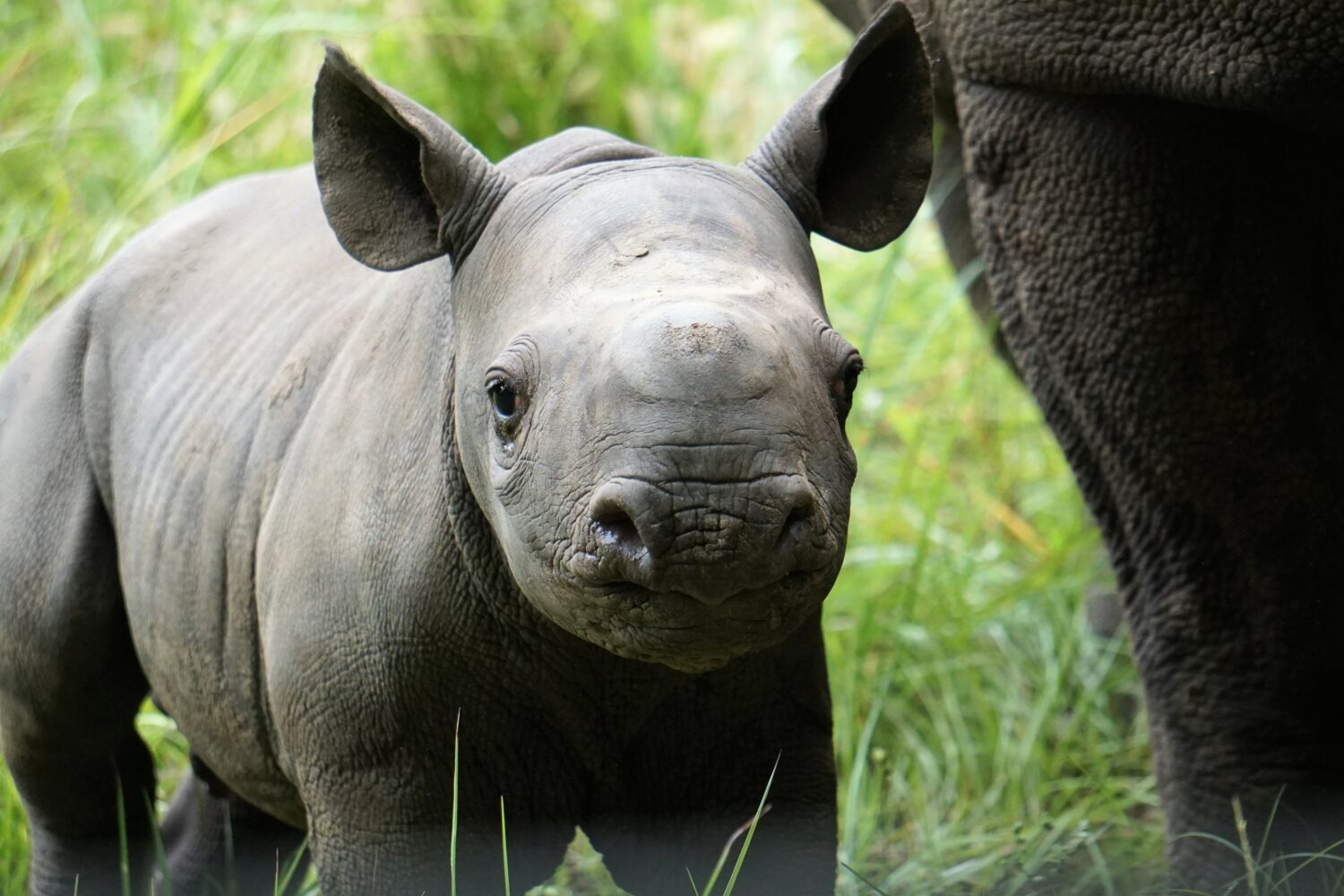Critically Endangered Black Rhino Calf Born at White Oak

White Oak Conservation, is pleased to announce the birth of a male black rhino.
Yulee, Fla. (December 21, 2020) — White Oak Conservation, a refuge for rare species in Northeastern Florida supported by philanthropists Kimbra and Mark Walter, is pleased to announce the birth of a male black rhino.
White Oak staff have named the feisty youngster “Rocky” after the boxing legend. Remarkable video and photos are available for media use here. (Mandatory credit: White Oak Conservation.)
The rhino was born to parents of South African ancestry. At birth in August, he weighed in at 70 pounds and at four months old, he now tips the scales at 250 pounds.
“Mom has been great and protective, keeping him very close,” said Brandon Speeg, director of conservation at White Oak. “That’s why in the wild, rhino calves are not a real easy target for carnivores. They have a large, protective mom to watch over them.”
Tragically though, rhinos are easy targets for poachers. In the past decade, thousands of rhinos have been killed by poachers for their horns.
As a result, black rhinos are now “critically endangered” throughout Africa. Rhino horns are illegally smuggled out of Africa to Asia, where they are traded on the black market as status symbols and as treatment for hangovers, headaches and fevers, even though they have no medicinal value. Rhino horns are made of keratin, the same as fingernails and hooves.
“Kimbra and I started our work in wildlife conservation with rhinoceroses because they have been so badly decimated throughout Africa,” said Mark Walter, White Oak’s owner. “We will continue to do everything we can to protect wild rhinos in Africa and to provide a safe refuge for them here in the United States.”
The Walters provide substantial funding for some of the most important rhino populations in Africa, where they fund anti-poaching efforts. Their teams protect rhinos and other wildlife; provide veterinary care and rehabilitate injured rhinos; and work with government wildlife departments and local communities to build support for their safety.
White Oak provides a protected home in the northeast corner of Florida for three of the world’s five remaining rhino species. White Oak’s 17,000 acres of quiet forest provide sanctuary for healthy and growing populations of black, white and greater one-horned rhinos (also known as Indian rhinos).
Rhinos first came to White Oak in 1985. Black rhinos from Zimbabwe were brought to White Oak in 1993 to start a breeding program in case the wild population was lost.
White Oak manages its rhino species as a critical part of collaborative species conservation plans. These plans guide White Oak and its partners as they support conservation efforts and build a sustainable North American population of rhinos as an assurance, or backup, population.
“Given the unabated poaching crisis, every rhino birth is precious,” said White Oak CEO Steve Shurter. “This rhino calf, especially, is a valuable addition that supports White Oak’s efforts to sustain and secure an assurance population of rhinos.”
To financially support White Oak’s conservation efforts, donations can be made online. Currently, private tours are available by reservation only. Please call 904-225-3396 or email info@white-oak.org to make a reservation.
Facts about black rhinos
- Africa is home to black rhinos and white rhinos.
- Rhinos occurred throughout Sub-Saharan Africa, but have been wiped out from 28 African countries
- In the wild, South Africa, Zimbabwe, Namibia and Kenya have the largest surviving populations
- They are classified as “critically endangered” by the IUCN Red List.
- Black and white rhinos both have two “horns” which are not true horns, but are actually compressed hair.
- Black rhinos are “browsers,” meaning they eat leaves
from bushes and trees. One distinguishing feature is their hooked upper lip which they use to strip leaves off branches.
- By 1993, only 2,300 black rhinos remained in the wild, down from approximately 65,000 in 1970.
- Due to incredible reintroduction and protection efforts, black rhinos were rebounding in many African countries and had grown to 5,600 individuals in 10 countries, but new consumption trends in Asia have led to escalating poaching again.
About White Oak Conservation and Walter Conservation
White Oak, which is a part of Walter Conservation, is a one-of-a-kind center for conservation. With 17,000 acres in northeastern Florida, it has long been dedicated to the conservation and care of endangered and threatened species, including rhinoceroses, okapis, bongos, zebras, Dama gazelles and cheetahs.
White Oak partners with wildlife agencies here and abroad. In the United States, White Oak collaborates with federal and state agencies on species recovery and release efforts for Florida panthers, Florida grasshopper sparrows, Mississippi sandhill cranes and whooping cranes. In addition to native species, eighteen endangered and critically endangered species have safe haven in spacious, natural enclosures at White Oak.
Through Walter Conservation, the Walter family conserves rare species and wild places around the world. Efforts include improving the quality of life of individual animals, recovering rare species, restoring ecosystems and protecting wilderness areas. For more information about causes supported and founded by the Walter Family please visit twfcauses.com.
Thus far, their philanthropy supports several areas in North America and Africa, protecting important wild populations of African elephants, rhinos, lions and many other species. The Walter Conservation approach is to protect and preserve large wild areas, provide wildlife security and management, to collaborate with local residents and host-country governments, and to invest in sustainable enterprises.
MEDIA CONTACT
Melissa Harris, CEO, M. Harris & Co.
312-401-7326 (m)
